Public vs Private Blockchain: Which Is Right For Your Needs?
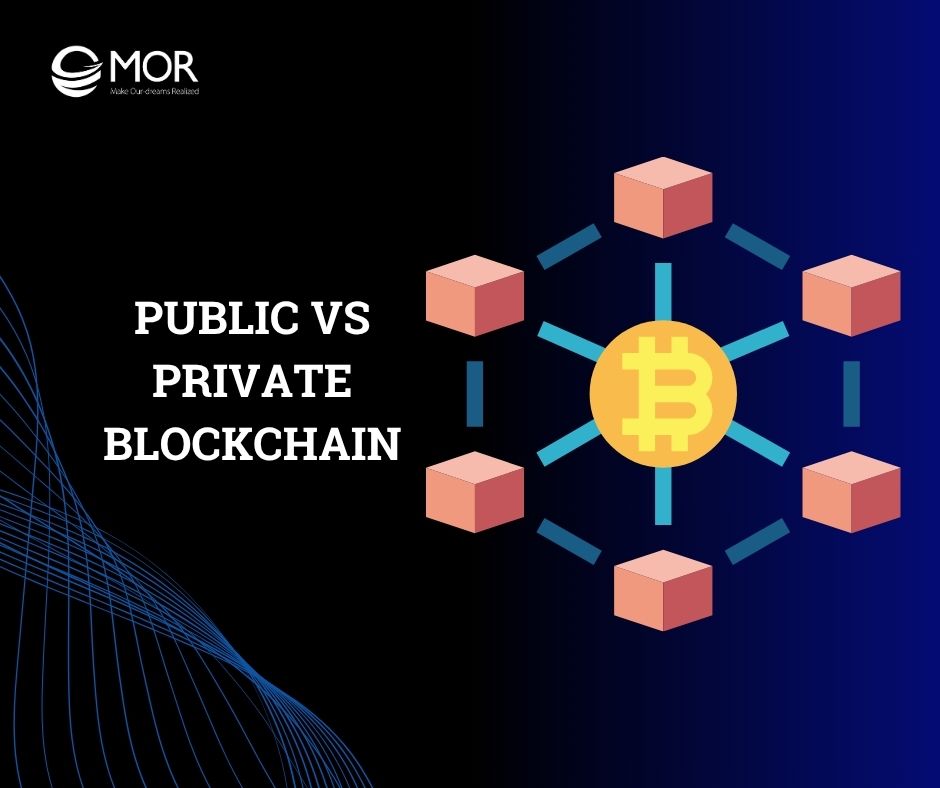
Is your business struggling to decide between a public or private blockchain for your next project? As blockchain continues to emerge as a core technology, understanding the differences between public vs private blockchain has become essential. In this article, MOR Software will provide an in-depth comparison of public vs private blockchain, empowering businesses to make informed decisions.
What Is A Blockchain And How Does It Work?
Blockchain is the foundational technology behind cryptocurrencies and many decentralized applications. To understand the difference between public vs private blockchains, it's essential to first grasp what blockchain is and how it works.

Definition of Blockchain
Blockchain is a distributed database system in which information is stored in time-stamped blocks that are securely linked together. Each block contains transaction data and is encrypted using cryptography. What makes blockchain different from traditional systems is its transparency, immutability, and ability to operate without a central intermediary.
Today, there are two main blockchain platforms widely used: public blockchains and private blockchains.
How Blockchain Works – Step-by-Step Process
A blockchain transaction involves more than just sending data; it follows a multi-step verification and recording process. The basic mechanism applies to both public blockchains and private blockchains, though implementation details vary.
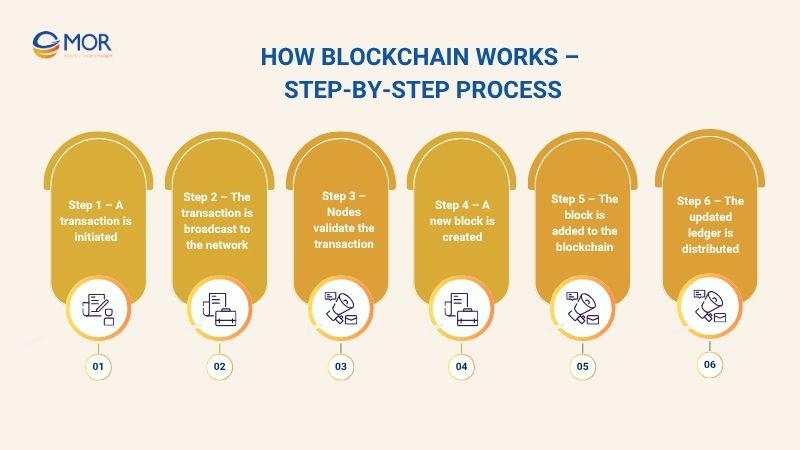
- Step 1 – A transaction is initiated: The process begins when a user creates a transaction, such as sending funds, executing a smart contract, or updating records. The data is packaged and prepared for submission to the network.
- Step 2 – The transaction is broadcast to the network: Once created, the transaction is broadcast to all nodes in the blockchain network, depending on the structure of the public blockchain vs private blockchain being used.
- Step 3 – Nodes validate the transaction: The nodes verify the validity of the transaction through a consensus mechanism. Different smart contract blockchain types apply different validation methods depending on their design.
- Step 4 – A new block is created: Once validated, the transaction is grouped with others into a new block, which is then encrypted and prepared to be added to the chain.
- Step 5 – The block is added to the blockchain: The new block is linked to the existing chain in a chronological and irreversible sequence, ensuring the integrity of the ledger.
- Step 6 – The updated ledger is distributed: After the block is successfully added, the updated ledger is distributed across the entire network. In public blockchains, this means syncing with all nodes; in private blockchain solutions, only authorized nodes are updated.
Public vs Private Blockchain Differences: Key Comparison Factors
Public and private blockchains are the two most widely used blockchain types, but they differ significantly in structure, accessibility, and performance. Understanding the core differences between public vs private blockchain models is essential for selecting the right solution for your project or organization. The comparison table below outlines the key factors that set these two systems apart.
Factor | Public Blockchain | Private Blockchain |
Accessibility and Participation | Fully open; anyone can join, read, and validate transactions | Restricted; only authorized participants can access and operate nodes |
Transparency and Privacy | All transactions are public and verifiable | Transaction data is private and visible only to selected parties |
Consensus Mechanism | Decentralized; uses PoW, PoS (resource-intensive) | Centralized or semi-centralized; often uses PBFT or lightweight models |
Scalability | Limited; performance may decrease as the network size grows | More scalable; customizable for enterprise needs |
Speed and Performance | Slower due to broader consensus requirements | Faster processing thanks to fewer nodes and a controlled environment |
Cost of Deployment and Operation | Higher, due to infrastructure and energy demands | Lower, with better cost control in closed environments |
Security and Trust Model | Relies on distributed nodes and cryptographic consensus | Depends on internal trust and centralized control |
What Is A Public Blockchain?
A public blockchain is an open and permissionless network where anyone can join, validate transactions, and view the shared ledger. This is the most common among all blockchain types, especially used in cryptocurrencies and decentralized applications (dApps).

Popular Examples: Bitcoin, Ethereum, Solana, Polygon, etc.
Key Characteristics of Public Blockchains
- Open participation: Anyone can read data, send transactions, and run a full node.
- Full transparency: All transaction records are visible and verifiable by the public.
- Permissionless structure: No approval is needed to join or interact with the network.
- High security: Relies on cryptographic consensus mechanisms like Proof of Work (PoW) or Proof of Stake (PoS).
- Censorship resistance: No single entity can alter or delete recorded data.
What Is A Private Blockchain?
A private blockchain is a permissioned network where only selected participants can access and interact with the system. Unlike public blockchains, private blockchain environments are managed by a single organization or a consortium, giving them control over access rights, node operations, and governance.

Example: Hyperledger Fabric, Corda, Quorum, RippleNet, etc.
Key Characteristics of Private Blockchains
- Restricted access: Only authorized entities can read, write, or validate transactions.
- Private data management: Sensitive information is visible only to approved participants.
- Customizable architecture: Tailored to meet business-specific rules and workflows.
- High performance: Fewer nodes result in faster transaction speeds and lower latency.
- Centralized governance: Managed by a trusted party or a defined set of stakeholders.
>>> READ MORE: What Is Blockchain Software Development? Guide, Tools, Best Tips
Public Vs Private Blockchain: Benefits And Drawbacks
When comparing public blockchain vs private blockchain, it's important to understand that each blockchain type offers unique strengths and limitations. This section explores the key benefits and drawbacks of both models to help you decide which is better suited for your project or organization.
Benefits of Public Blockchain
Public blockchains offer numerous advantages, especially for open systems that prioritize decentralization, transparency, and community participation. Below are the main benefits when choosing a public blockchain vs a private blockchain architecture.
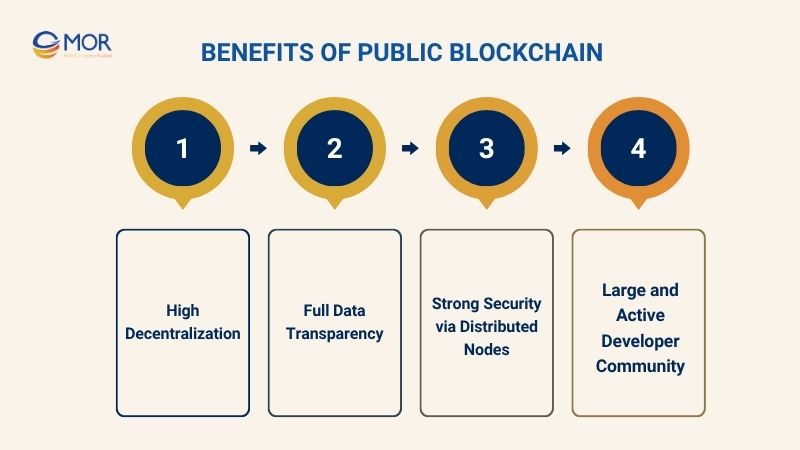
High Decentralization
In public blockchains, anyone can join the network without requiring permission or registration from a central authority. This decentralized structure ensures that no single entity can control the entire network.
As a result, it reduces the risk of data manipulation or localized failures. This is a key factor when comparing private vs public blockchain, especially in systems that demand high transparency and democratic governance, such as DeFi or DAOs.
Full Data Transparency
With public blockchains, all transactions are publicly recorded on a distributed ledger and can be verified by anyone at any time. As of mid-July 2025, the Ethereum network processes approximately 1.5 million transactions per day, with a peak day reaching 1,647,890 transactions.
This transparency builds trust among participants and serves as a natural auditing mechanism. Therefore, public blockchain is ideal for use cases such as decentralized voting, public token issuance, or community financial tracking.
Strong Security via Distributed Nodes
Public blockchain systems use thousands of independent nodes to verify transactions and maintain network integrity. This distributed structure makes it nearly impossible to attack or alter the data, as a malicious actor would need to control most of the network nodes simultaneously.
Compared to the private blockchain vs public blockchain model, the public approach theoretically offers a higher level of security, especially against external attacks.
Large and Active Developer Community
Another major strength of public blockchains is their large and active developer communities. According to GitHub weekly statistics, Ethereum leads with 13,786 commits, followed by Solana (3,860), Polkadot (9,316), and Polygon (1,665), demonstrating high source code contribution from developers worldwide.
This contributes to a robust and continuously evolving ecosystem, which is something many smart contract platforms struggle to replicate due to their closed nature.
Drawbacks of Public Blockchain
Despite their advantages, public blockchains also come with certain trade-offs, particularly in terms of speed, scalability, and operational cost. These limitations are important to consider when comparing private blockchain vs public blockchain platforms.

Slower Transaction Speed
Due to high decentralization, public blockchains often require consensus across multiple nodes throughout the network. This validation process slows down transaction speed, especially in networks using resource-intensive mechanisms like Proof of Work (PoW).
High Operational and Transaction Costs
Running a public blockchain network requires substantial energy and powerful hardware, especially in PoW systems like Bitcoin. In addition, transaction fees often spike during periods of network congestion.
In May 2025, the average fee on the Bitcoin network reached $2.40 per transaction, the highest of the year. This is a clear disadvantage when comparing public vs private blockchains, where private blockchains allow for more predictable and lower-cost operations.
Scalability Limitations
Scalability remains one of the biggest challenges for public blockchains. Because every node must validate transactions and store a full copy of the ledger, these systems face significant hurdles when trying to scale up for higher transaction volumes or user bases.
Benefits of Private Blockchain
Private blockchains are well-suited for enterprises that require control, performance, and compliance. They allow businesses to build private blockchain solutions with customized permissions and data governance while maintaining security within a trusted network.
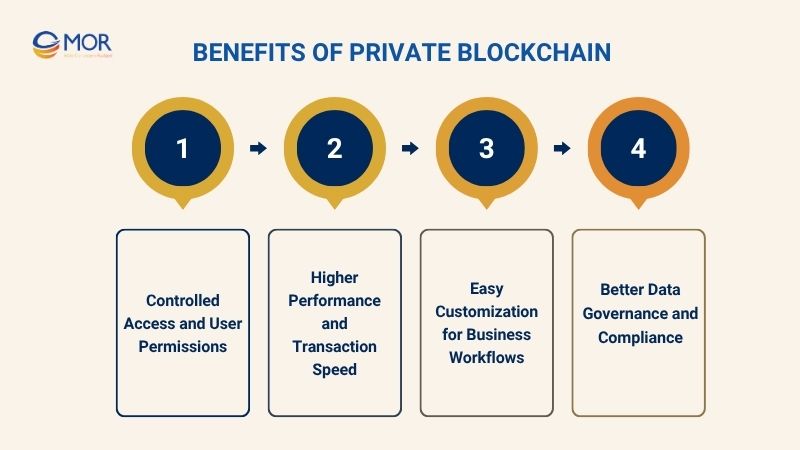
Controlled Access and User Permissions
In a private blockchain, access rights are managed by a specific organization or a consortium. This means only authorized participants can read, write, or validate transactions.
This level of control allows for clear information flow management and ensures that only responsible parties can interact with the system. Compared to public blockchain vs private blockchain, the latter provides a more secure environment for sensitive enterprise operations.
Higher Performance and Transaction Speed
Thanks to the smaller number of nodes and a simplified consensus process, a private blockchain can achieve significantly faster transaction speeds than public blockchains. Since the system does not need to wait for thousands of nodes to reach consensus, latency is reduced, and throughput is increased.
According to a research paper by the Hyperledger Fabric development team, their system achieved over 3,500 transactions per second (TPS) with latency under 1 second when deployed with over 100 peer nodes.
Easy Customization for Business Workflows
Unlike public blockchain networks, which tend to follow rigid, global rules, private blockchain solutions offer flexible customization tailored to the needs of individual organizations. Features such as data models, consensus mechanisms, access rights, and transaction rules can be uniquely designed according to specific business logic.
This flexibility is crucial for enterprises that require the blockchain to integrate with existing workflows or evolve.
Better Data Governance and Compliance
With a private blockchain, organizations maintain full control over their data processing chain. This enables the easy implementation of security policies and compliance with legal and regulatory requirements.
From managing access permissions and data storage to setting up audit trails, all aspects can be customized to align with internal standards or regulations such as GDPR or HIPAA.
Drawbacks of Private Blockchain
Private blockchains provide strong benefits in efficiency, performance, and compliance. However, they often compromise key principles of blockchain technology. These limitations are crucial when comparing private blockchain vs public blockchain, especially in systems that require openness and distributed trust.
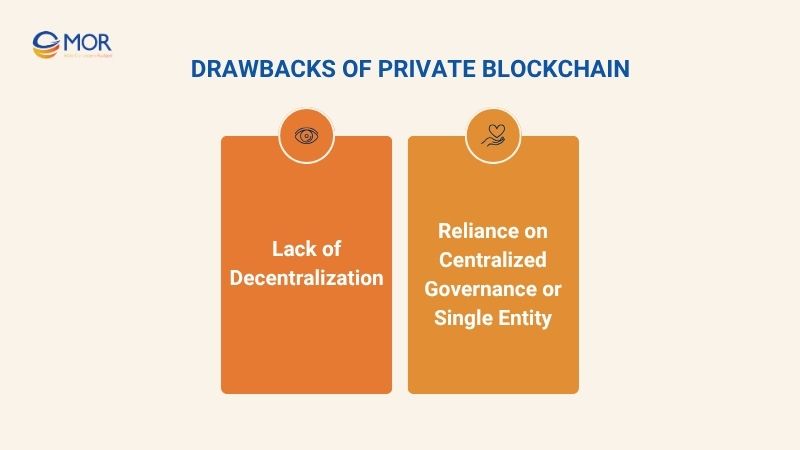
Lack of Decentralization
Unlike public blockchains, which are operated by thousands of independent nodes worldwide, private blockchains are typically governed by a single organization or a small group of participants.
In one test deployment of Hyperledger Fabric v1.1, the network was configured with 4 ordering nodes and 4 endorsing peers. Performance decreased significantly when scaling beyond 8–16 peer nodes.
Reliance on Centralized Governance or Single Entity
Private blockchain systems rely heavily on a central authority to assign permissions, validate transactions, and make system-wide changes. While this centralization enables efficiency, it also introduces a single point of failure and risk. If the controlling entity acts dishonestly or suffers technical issues, the entire blockchain system could be compromised.
Top Real-World Use Cases For Public And Private Blockchain
Choosing between a public vs private blockchain model depends on your specific use case. Below, we explore real-world examples of how each blockchain type fits different industries, helping businesses decide which route to take in the blockchain public vs private discussion.
Use Cases For Public Blockchain
In scenarios where transparency, community engagement, and open access are essential, public blockchains shine. The examples below demonstrate where a public blockchain vs a private blockchain model makes the most sense.
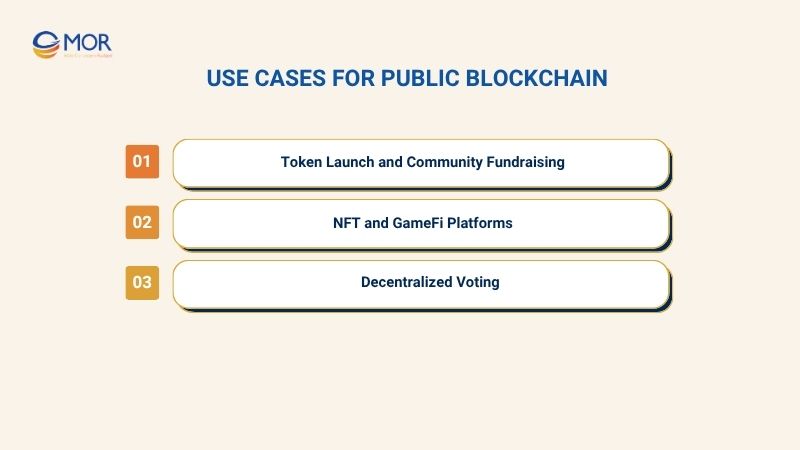
Use Case 1 – Token Launch and Community Fundraising
A DeFi startup called NovaLend is building a peer-to-peer lending platform. To scale their operations, they aim to raise capital from a global community by launching their native token, $NOVA.
Solution: NovaLend chooses to deploy its ERC-20 token via smart contracts on the Ethereum public blockchain. This enables them to launch a transparent token fundraising round through platforms like launchpads or directly via non-custodial wallets.
Reasons:
- All token transactions are publicly recorded, ensuring transparency and building community trust, something private blockchain solutions cannot easily offer.
- Tokens can seamlessly integrate with the broader DeFi ecosystem (DEXs, wallets like MetaMask), which is not feasible on private blockchains.
- Public blockchains provide access to a large, global user base, increasing fundraising efficiency compared to a private vs public blockchain architecture.
Use Case 2 – NFT and GameFi Platforms
A Web3 game studio named MetaMonsters is developing an action game where players collect, upgrade, and trade NFT-based characters. They need a platform that supports true asset ownership and open trading markets.
Solution: MetaMonsters mints its game NFTs on the Polygon public blockchain, records transactions on-chain, and integrates Web3 wallets such as MetaMask.
Reasons:
- By leveraging public blockchains, players gain verifiable, permanent ownership of digital assets — unlike centralized private blockchain solutions.
- Public networks support integration with open NFT marketplaces like OpenSea, which private chains typically cannot access.
- The openness of blockchain public vs private systems makes public blockchains ideal for building interoperable GameFi ecosystems.
Use Case 3 – Decentralized Voting
An environmental DAO called GreenDAO manages a global fund with thousands of community members. They need a secure, transparent voting system to decide on funding proposals.
Solution: GreenDAO uses a voting platform built on a public blockchain like Ethereum or Arbitrum to log all votes on-chain, with each wallet address representing one vote.
Reasons:
- Votes are publicly and immutably stored, ensuring full transparency and tamper resistance.
- Anyone can verify the results on-chain, eliminating concerns over manipulation, a critical difference between blockchain public vs private models.
- No need for centralized oversight or third-party validation, reducing costs and risks, something private blockchain vs public blockchain setups cannot match.
Use Cases for Private Blockchain
On the other hand, private blockchains are better suited for organizations that need full control over data access, security, and compliance. Let’s look at situations where a private vs public blockchain model offers clear advantages.
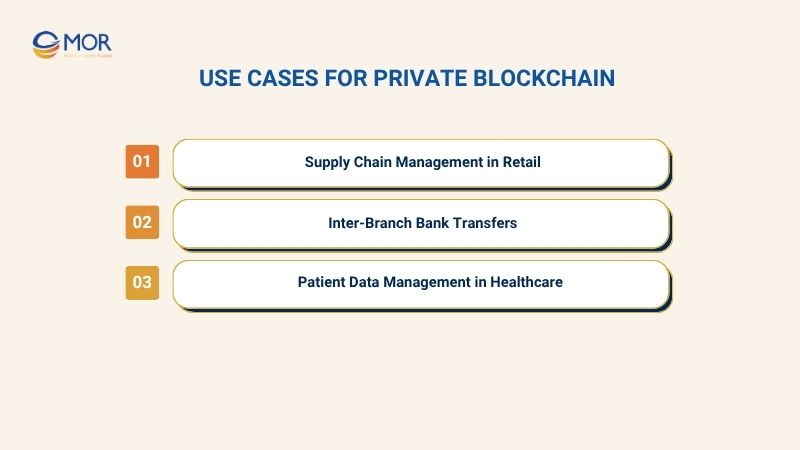
Use Case 1 – Supply Chain Management in Retail
A retail giant named RetailLink wants to enhance transparency and traceability throughout its supply chain. They need secure and role-based data access among different stakeholders, including suppliers, logistics providers, and auditors.
Solution: RetailLink deploys a private blockchain solution using Hyperledger Fabric. They assign permissioned access to authorized nodes, where each stakeholder (supplier, shipper, auditor) operates their own node with specific roles and visibility.
Reasons:
- Internal supply chain data remains secure and protected within a controlled network, avoiding exposure like in public blockchains.
- Each party accesses only the data relevant to their responsibilities, ensuring controlled data visibility — a key benefit of private blockchain solutions.
- This architecture simplifies regulatory compliance, especially for industries handling sensitive logistics data, where public blockchain vs private blockchain models differ significantly.
Use Case 2 – Inter-Branch Bank Transfers
A multinational bank named GlobalTrust needs to process high volumes of internal transactions between branches across different regions. The system must ensure privacy, low latency, and operational control.
Solution: GlobalTrust adopts a private blockchain built on Corda, connecting key departments such as accounting, operations, and compliance. Transactions between branches are verified in real-time without exposing data externally.
Reason:
- Confidentiality is maintained across all transactions, avoiding public exposure inherent in public blockchains.
- The bank retains full operational control, assigning roles and permissions without depending on decentralized governance, highlighting a core difference in blockchain public vs private models.
- The system achieves high throughput due to fewer nodes and optimized consensus, a key performance benefit in the private vs public blockchain comparison.
Use Case 3 – Patient Data Management in Healthcare
A nationwide hospital system called MediChain wants to enable secure sharing of patient health records across branches and departments while complying with healthcare privacy regulations.
Solution: MediChain builds a private blockchain where only authorized medical personnel can access and update patient data. Each department operates a permissioned node.
Reasons:
- The system ensures data privacy and meets stringent legal requirements like GDPR and HIPAA, which public blockchains cannot fully guarantee.
- With customized access control, each medical role interacts only with necessary records, a flexibility unique to private blockchain solutions.
- Streamlined collaboration between clinics and departments becomes possible without sacrificing compliance — a distinct advantage of private vs public blockchain setups in sensitive industries like blockchain technology in healthcare.
In Conclusion
Whether adopting a public or private blockchain, each option presents unique advantages and challenges depending on a business’s objectives. Through the analysis above, organizations can gain a clearer understanding when deciding between public vs private blockchain. Don’t hesitate to contact MOR Software; we are always ready to support your enterprise in a secure and effective digital transformation journey.
MOR SOFTWARE
Frequently Asked Questions (FAQs)
If public blockchains are more transparent and secure, why do businesses still choose private ones?
Because businesses need control over data, legal compliance, and performance optimization, things that public blockchains can’t always guarantee.
Is there a “hybrid” option between public and private blockchains?
Yes, it’s called a consortium blockchain, a semi-decentralized model where access is limited to selected participants. Examples include Quorum and Hyperledger Besu.
Does a private blockchain lose the essence of decentralization?
To some extent, yes. Private blockchains are typically governed by a single organization or a small group, so decentralization is limited.
Can a business use a public blockchain and still keep its data private?
Yes, using techniques like zero-knowledge proofs or Layer 2 solutions allows businesses to leverage public infrastructure while maintaining privacy.
Can private and public blockchains connect?
Yes, through cross-chain bridges or oracles, it’s possible to exchange data or digital assets between private and public blockchains.
Rate this article
0
over 5.0 based on 0 reviews
Your rating on this news:
Name
*Email
*Write your comment
*Send your comment
1